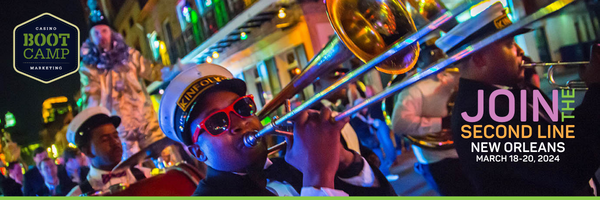We have all witnessed the transformative impact of a well-crafted brand strategy on marketing efforts. A strong brand strategy can serve as the foundation for successful marketing, amplifying the effectiveness of initiatives and campaigns and delivering remarkable results. And, as dynamic and competitive as the casino industry can be, it is no different. I have witnessed this firsthand.
Imagine a scenario where every element of your casino’s marketing initiatives seamlessly aligns, resonates, and captivates your target audience. Picture your advertising, social media presence, direct marketing, promotions, events, and guest and employee experiences all working in harmony, reinforcing your brand story and driving customer engagement. THIS is the power of a cohesive brand strategy.
 A brand strategy is a guiding compass at its core, providing direction and purpose to every marketing endeavor. At its most typical application, it can ensure that all messaging, visuals, and experiences are consistent, compelling, and authentic, creating a cohesive identity that sets your casino apart from the competition. At its best, it guides behavior and decision-making.
A brand strategy is a guiding compass at its core, providing direction and purpose to every marketing endeavor. At its most typical application, it can ensure that all messaging, visuals, and experiences are consistent, compelling, and authentic, creating a cohesive identity that sets your casino apart from the competition. At its best, it guides behavior and decision-making.Brand Strategy and Advertising
The impact of brand strategy on advertising is perhaps the most obvious. Yet, sadly, I feel like strategy seems to slip through the cracks much more quickly because we often approach it as a bit of a checklist.
Logo. Check. Tagline. Check. Commonly-used imagery. Check.
Beyond providing consistency in look and feel, a well-defined brand strategy is a solid foundation for crafting compelling and memorable advertisements that resonate with the target audience. Still, we regularly see examples of competitors whose advertising looks very similar, with the only differentiation being the logo. Casinos seem to be notorious for this. Perhaps it’s because we share many standard features and target audiences. Maybe the messages are not based on a brand strategy but rather a creative direction.
So, how do you overcome this challenge?
As the person influencing or in charge of the advertising, you should always think about the overall strategy and the goals for how a guest develops their pre-visit expectations and whether that meets the purposes of your brand strategy. In a way, you work backward, starting with the creative brief.
- We want the (target audience) to (action)
- Because (reasons)
Then, go through the process in a forward direction to check problems.
- Our overall goal is (business strategy)
- We do this by (brand strategy)
- So, we’ve created this tactic that will cause our (target audience) to (action) to help us get closer to our goal
This last step will allow you to evaluate whether the program you are communicating will be additive or not to your overall strategy.
Brand Strategy and Social Media
Brand strategy is critical in shaping a brand’s social media presence. It provides a framework that guides the tone, content, and visual elements across various social media channels. Shank Marketing Principal Justin Shank emphasizes, “Social media channels allow casinos to showcase their brand personality, not just to promote the latest giveaway. A well-executed brand strategy ensures consistent messaging and builds authentic connections with the audience.”
Casinos that have effectively utilized brand strategy in their social plan have reinforced their brand identity and engaged with customers meaningfully. For instance, Choctaw Casinos has developed a brand strategy centered around being a fun, energetic, and innovative gaming destination just a short drive from its largest feeder market. The brand maintains a consistent and vibrant tone on social media platforms, using playful and exciting language to interact with its audience. Their content aligns with their brand strategy, featuring amenities with a background of energetic music to reflect their brand personality. Through this cohesive approach, Choctaw Casinos attracts a loyal following and strengthens its brand image in customers’ minds.
 Another notable example is Tachi Palace Casino Resort, which has strategically used social media to enhance its brand positioning as a must-see resort destination. With a brand strategy focused on fun, winning and behind-the-scenes glimpses are mainstays in their social media. By carefully selecting music and visuals, Tachi’s social media presence consistently reinforces its brand image and entices its target audience.
Another notable example is Tachi Palace Casino Resort, which has strategically used social media to enhance its brand positioning as a must-see resort destination. With a brand strategy focused on fun, winning and behind-the-scenes glimpses are mainstays in their social media. By carefully selecting music and visuals, Tachi’s social media presence consistently reinforces its brand image and entices its target audience.In both these cases, brand strategy serves as a guiding force, ensuring that the casinos’ social media content aligns with their desired brand positioning and resonates with their audience. By maintaining a consistent and authentic brand voice across social media platforms, these casinos have built strong connections with their customers, increased engagement, and reinforced brand loyalty.
Brand Strategy and Direct Marketing
It is intriguing how casino operations often perceive direct marketing and advertising as separate silos. However, it is essential to recognize that direct mail is indeed a form of advertising. While it’s true that direct marketing serves as the delivery mechanism for offers and return visits, we must acknowledge that a significant portion of the content in mailers has historically been dedicated to selling and enhancing the desire to revisit.
One of the critical ways brand strategy influences direct marketing is through design. The language, visual elements, color schemes, typography, and overall aesthetics of direct marketing materials are all carefully crafted to align with the casino’s brand identity. For example, a casino with a brand strategy centered around modernity and excitement may use bold and vibrant colors, sleek graphics, and dynamic imagery in its direct marketing materials. By doing so, the design elements reinforce the desired brand image and create a consistent visual experience for recipients.
 Surprisingly, if we remove the logos from mailers across competitors in a market, they tend to appear strikingly similar. Although research consistently shows that customers are primarily interested in the offers and use them to determine their visitation schedule, it would be remiss to neglect the importance of creative elements in direct mail. Just as we wouldn’t consider sending coupons without creative effort, why shouldn’t we also consider the brand strategy when crafting our mail?
Surprisingly, if we remove the logos from mailers across competitors in a market, they tend to appear strikingly similar. Although research consistently shows that customers are primarily interested in the offers and use them to determine their visitation schedule, it would be remiss to neglect the importance of creative elements in direct mail. Just as we wouldn’t consider sending coupons without creative effort, why shouldn’t we also consider the brand strategy when crafting our mail?Following the reopening phase after the COVID-19 pandemic shutdowns, we collaborated with a client who noticed a difference in the types of guests entering their establishment. They wanted to make changes to their direct mail based on this observation. We delved into their brand strategy during our discussions and contemplated how these new guests might align with it. This exploration made us realize that the necessary changes were more of an update or tweak to the look and feel rather than a complete overhaul. It became evident that honoring the brand was ultimately the driving force behind the emerging visitation patterns.
This case is an exceptional example of how a brand strategy can keep us focused. It is easy to spot differences and react quickly, but the smaller, more nuanced, and brand-appropriate shifts often yield long-term success. By integrating brand strategy into direct mail creation, we can ensure a consistent and compelling brand experience throughout the customer journey, ultimately enhancing engagement and fostering loyalty.
Content is another crucial aspect influenced by brand strategy in direct marketing. Direct marketing materials’ messaging, tone, and storytelling must be strategically crafted to reflect the brand’s values and unique selling propositions. A casino with a brand strategy that offers a luxurious and personalized experience might use language that evokes exclusivity and indulgence in its direct marketing content. A casino brand focused on a fun, friendly environment may use more people and warmer tones in language and coloring. Consistent messaging across all direct marketing channels will help reinforce the casino’s brand positioning and cultivates a sense of trust and familiarity with the audience.
Moreover, brand strategy is pivotal in targeting strategies for direct marketing efforts. A well-defined brand strategy helps identify the casino’s target audience and their preferences, enabling more precise and effective targeting. For instance, a casino with a brand strategy targeting high-end clientele may leverage direct marketing channels to reach individuals who fit the desired demographic profile, such as personalized, exclusive email offers. By aligning the targeting strategies with the brand strategy, the casino can enhance the relevance and effectiveness of its direct marketing initiatives.
Brand Strategy and Promotions/Events
Brand strategy is crucial in creating unique and memorable experiences for casino guests. By understanding the target audience and their preferences, a well-crafted brand strategy can help casinos design events and giveaways that cater to their customers’ interests and desires. Whether it is a themed party, exclusive VIP experience, or interactive game, the brand strategy ensures that each element of the event or giveaway reflects the casino’s brand personality and enhances the overall guest experience.
Brand strategy can significantly shape casino giveaways and events, influencing how they align with the casino’s brand identity and values. As Casino Marketing Boot Camp coach Nicole Martz rightly points out, “Promotions and events become more impactful when they reflect the casino’s brand identity and values. A well-crafted brand strategy ensures that every promotion and event reinforces the brand story.”
By incorporating brand strategy into giveaways and events, casinos can create experiences that are not only enjoyable but also resonate with their target audience. For example, a casino with a brand strategy centered around “finding your fun” may organize a giveaway with travel packages to exotic destinations or outdoor adventure experiences. By doing so, the casino reinforces its brand positioning and offers an experience that aligns with its customers’ aspirations and desires.
Additionally, the brand strategy helps casinos differentiate themselves from competitors by creating distinctive and memorable experiences. Casinos can leave a lasting impression on guests by infusing their unique brand story into every aspect of the event or giveaway, fostering loyalty and word-of-mouth referrals. From the visual aesthetics to the activities and interactions, every detail is thoughtfully crafted to create a cohesive and immersive brand experience.
Examples of effective brand strategy alignment exist around us. For instance, Red Bull, known for its brand strategy centered around extreme sports and energy, organizes events such as the Red Bull Cliff Diving World Series. This event aligns with the brand’s adventurous image and provides participants and spectators with an immersive and thrilling experience. Similarly, Nike’s brand strategy of empowerment and athleticism was exemplified when it dropped the subscription fee for its Nike Training Club Premium service when gyms shut down, and health authorities encouraged the public to say in during the COVID-19 pandemic.
Brand Strategy and Guest/Employee Experiences:
Brand strategy plays a pivotal role in shaping guest and employee experiences within a casino. As experience expert Jim White aptly states, “A strong brand strategy guides the overall guest and employee experiences, creating a cohesive and authentic environment that embodies the casino’s brand promise.”
Casinos that have successfully integrated their brand strategy into guest services and employee training exemplify the power of a well-defined brand. For instance, Isle of Capri Casinos relied on their brand strategy to create the successful See Say Smile initiative. The courtesy program allowed them to engage team members and guests uniquely, stimulating return visits and enhancing NPS scores and team member bonuses.
A well-defined brand strategy helps create a unique and memorable experience for guests. A casino can create a unique identity that sets it apart from competitors by incorporating the brand personality and values into various touchpoints, such as the physical environment, communication style, and service delivery. This differentiation contributes to a positive guest experience and helps the casino stand out in customers’ minds.
Additionally, when the brand promise is consistently delivered throughout the guest experience, it fosters customer satisfaction by meeting or exceeding their expectations. Guests feel a sense of trust and familiarity, leading to increased loyalty and repeat visits.
More importantly, a clear brand strategy gives employees a sense of purpose and direction. When employees understand the brand values and how they relate to their roles, they become brand ambassadors who actively contribute to delivering the brand promise. This alignment leads to higher employee engagement, job satisfaction, and a sense of pride in their work, ultimately positively impacting the guest experience.
A brand strategy is meant to guide more than the surface of the brand. It should guide all operational efforts along with the growth of the business. It should be understandable by anyone charged with decision-making. It should also be easily distilled and understood by everyone in the organization, whether they have customer-facing roles or not because a brand strategy amplifies all we do.



Recent Comments